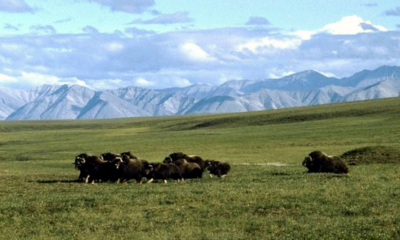Alaska
Moose Kills Alaska Man

An Alaska man’s attempt to take pictures of two newborn moose calves turned fatal Sunday morning, when the calves’ mother attacked the 70-year-old, killing him. Dale Chorman of Homer was with a second unidentified man when they came upon the animals in the brush, a spokesperson for the state’s Department of Public Safety says. Chorman was attacked as the two were running away, the AP reports. The cow moose charged the men and kicked Chorman, according to an official statement. He died on the scene, the Anchorage Daily News reports. The moose left the area, and the investigation is ongoing.
About 737,000 humans and 200,000 moose live in Alaska, and the animals can be aggressive if provoked—especially moms with babies. A 71-year-old man was stomped to death in 1995 after students reportedly harassed a moose and its calf for hours on the University of Alaska Anchorage campus; the man then tried to walk past the animals to enter a building. “Calving season for moose is the time when you definitely want to give them extra space,” the public safety spokesperson says. “Cow moose with calves are going to be some of the more aggressive moose you’re going to come in contact with.” (More Alaska stories.)

Alaska
Flu ‘increased notably’ in Alaska in last month, AK Dept. of Health says

ANCHORAGE, Alaska (KTUU) – New data shows the number of confirmed Alaska flu cases more than doubled from the last report, according to the Alaska Department of Health (DOH) snapshot data for the week of Dec. 20.
Flu cases have been on the rise since mid-November, according to the updated Alaska Department of Health Respiratory Virus Snapshot published Dec. 20, 2025. This December update saw the largest jump in cases since the increase started, going from 391 lab-confirmed cases the week of Dec. 13 to 816 the week of Dec. 20.
It’s quite a rise from the same time last year, which reported only 108 lab-confirmed cases in the week of Dec. 21, 2024, but the next week, which had the reporting date of Dec. 28, 2024, saw a jump in cases to 484.
And this past week’s numbers rivals the 2025 peak at 990 cases reported March 1, 2025, according to the DOH.
The highest spike of influenza cases reported over the past five years was on Dec. 13, 2022, with 1,621 cases reported that week.
The state reported in the Alaska Influenza Surveillance Summary that last year Alaska saw a “higher number of reported cases than in previous years, with activity more concentrated in a pronounced peak.”
A national trend
The CDC said the flu season is just starting and is potentially gearing up to be substantial.
“I don’t think I ever remember seeing it this severe, this soon,” Dr. Suchitra Rao, an infectious disease specialist at Children’s Hospital Colorado in Aurora, told NBC News. “Our emergency department is full of kids coming in with the flu.”
The CDC said the flu is increasing across the country, but that the timing “is similar to several past seasons.”
The CDC estimates during this season there have been 4.6 million flu cases, 49,000 hospitalizations (a little over 1% of cases) and 1,900 deaths.
Those numbers also rival data from last year, where the CDC estimated 5.3 million cases, 63,000 hospitalizations and 2,700 deaths.
COVID-19 & RSV
The flu is not the only respiratory virus the state is tracking.
As of the latest Department of Health snapshot, 50 cases of COVID-19 were reported have been reported for the week of Dec. 20, a drop from last year’s report of 82 cases during the same time period, the DOH reported.
RSV cases are also lower than previous years right now.
During the week of Dec. 20, 75 cases of RSV were reported, which is much less than the 266 reported cases the same time last year, according to the DOH.
Data over the past five years from the Department of Health shows the months between December and March are when RSV is most active in Alaska, peaking between the last weeks of December to the first weeks of January.
How to stay healthy
The CDC lists several ways to help prevent spreading or catching the flu, but said the “single best way to reduce the risk of seasonal flu and its potentially serious complications is to get vaccinated each year.”
While data from the CDC shows getting vaccinated could decrease a visit to the doctor by 40 to 60%, it doesn’t mean you won’t get sick.
This makes strategies that protect yourself and others from spreading germs all the more important.
Tips from the CDC include: avoiding close contact, staying home if sick, covering mouth and nose (even if not sick), washing hands, avoiding touching eyes, nose or mouth, taking steps for cleaner air and practicing good hygiene.
See a spelling or grammar error? Report it to web@ktuu.com
Copyright 2025 KTUU. All rights reserved.
Alaska
How the issue of dual participation created a rift in Alaska’s youth hockey community

Traditionally, youth hockey players ages 14 to 18 have been permitted to participate in games and practices for both their local high school and Team Alaska, the state’s lone AAA tier competitive league program.
After receiving feedback from a majority of players’ parents, Team Alaska program director and 18U head coach Matt Thompson and fellow coaches at other age levels decided that their players wouldn’t be permitted to play both this year.
“When you’re reviewing things, you’re trying to look at what is the bigger voice and what do people want: How did our teams do? Did we have success? Were there issues here? And then we ask all the coaches,” Thompson said.
The high school and comp teams share the goal of developing young Alaska hockey players, but the decision has put a strain on their relationship. Many high school coaches disagree with the either/or approach. Generally, high school teams acquiesce to regular absences by some of their top players during the regular season to allow them to compete at both levels.
“You’re taking kids away from the game they love and they’ll never get these years back,” West High head coach Rob Larkey said.
Every year, the coaches of each youth program from 14U to 18U are allowed to decide whether to allow players to take part in both the high school and competitive league seasons.
Last year only the 14U team, which consists of mostly high school freshmen and middle schoolers, and 18U, which includes high school juniors and seniors, permitted their players to do both.
At the end of every season, Thompson sends surveys to parents and legal guardians of players so they can provide feedback on how the program can improve and voice concerns anonymously.
Thompson said after last season, they sent out 60 surveys, and only a few voiced appreciation for dual participation. Many more came back expressing frustrations about a lack of commitment from the team as a whole.
By late summer, the Team Alaska coaches had decided to stop allowing dual participation.
“This isn’t just a decision on me, it’s a decision by the program collectively,” Thompson said. “I backed those coaches, and they asked me to send an email out at the end of August just to reaffirm that we were doing that because there were a lot of people asking questions to those coaches.”
After sending the email, he said he didn’t receive any correspondence from concerned parents or coaches about the decision aside from Kevin Fitzgerald, an assistant coach at West High School.
Thompson and 18U coach William Wrenn met with the coaches from West in June, but the meeting turned sour on the topic of dual participation, which led to some friction between the two parties.
In early October, Fitzgerald, himself a former comp coach, sent a lengthy letter to hockey families outlining his criticisms of the decision. It included a number of responses to issues raised in the meeting as well as reasons players should consider high school hockey as opposed to club hockey.
“That was the only school that we heard from,” Thompson said. “One school that had an opinion on something. A school that I went to and played for sent out a letter that stirred up the pot a little bit.”
Forcing a decision
There was a point earlier in the year when it was unclear whether there would even be a 2025-26 high school hockey season. It was one of three high school sports on the chopping block during the Anchorage School District’s budget discussions in the face of a large budget deficit.
During the summer, when the season was still up in the air, Larkey said Team Alaska asked West players who play for both teams about their plans for the upcoming winter. The players couldn’t give a concrete answer because nothing had been finalized at the time.
Since the sport was ultimately spared from cuts, Larkey believes it’s unfair to make players and their families choose between the two.
“You’re forcing the kids that love the game and want to play the game to make a choice on that,” Larkey said.
In doing so, he thinks that Team Alaska has put more pressure on itself to perform better if they’re going to have players who play only for them year-round.
“Where are you going to measure yourself?” Larkey asked. “You should be getting out of regions and going to nationals. If not, then where are you at and how many of your players are going on (to play at the next level)?”
Chugiak head coach Rodney Wild believes kids are being forced to make a choice between the two, and in most cases, it’s not theirs to make.
“I don’t buy the reasoning as to why,” he said. “They’re doing it because they believe it’s in the kids’ best interest, I truly believe that. They’re not doing it to hurt the kids or put the kids at a disadvantage. They truly believe that what they’re doing is best for their players. I just don’t agree with it.”
Often, it’s the parents who are making the final decisions on behalf of their student-athletes. In many cases, players want to play for their high school teams as well.
South High lost between 10 and 15 players to the decision, but that hasn’t stopped them from opening the season on a high note as the lone undefeated team in the Cook Inlet Conference.
“South gets hammered the most with those Team Alaska guys but it’s OK,” Wolverines head coach Daniel Ramsey said. “We’ve had some JV kids come up, we’re in our fourth season now so our seniors are big on this team. That’s who our first line is, all seniors.”
High school hockey benefits
The high school coaches at West, Chugiak and South referenced the type of overwhelming support that comes with playing at that level. There are often big crowds featuring friends, family, faculty, alumni and the community at large. In travel hockey, teams typically play in front of scarce audiences predominantly made up of parents.
“I coached comp hockey too, and all you do is go to the arenas and moms and dads are the only ones in the arenas,” Larkey said. “There’s no cheerleaders in the crowd leading chants or a band being played. It’s a different excitement.”
The rivalry games between Chugiak and neighboring Eagle River average around 1,000 fans filling the stands and lining the rink at the Harry J. McDonald Memorial Center, providing an atmosphere that is “absolutely raucous,” said Wild.
“I feel like the kids are being forced to sacrifice an experience that they will not be able to replicate after they’re done playing (youth) hockey,” Wild said. “They’re robbing these kids of an opportunity, and they’ll tell you that there’s nothing like playing high school hockey.”
Many youth hockey players won’t get a chance to play in front of a packed arena outside of high school unless they play for a good junior hockey team in a passionate community.
“I think it’s really cool being able to play for your high school because you get to represent your school and represent the hockey team,” South sophomore forward David Berg said. “You really get to put out for your school and your fans.”
West wasn’t hit as hard as some of the other teams when it came to the volume of players they lost to Team Alaska’s decision. Larkey said five players are forgoing the high school season to commit to Team Alaska.
“We don’t want kids to throw their Team Alaska away either,” he said. “We don’t want to interrupt them as well.”
Possible resolutions
Youth hockey is the rare sport in the state in which the high school season overlaps with the competitive league season.
According to Thompson, the Team Alaska program director, the conflicting schedules are the most detrimental to Team Alaska at the time when the team needs to be at its best and sharpest, around the time of the high school regional tournament.
Thompson said he’s spent the past four years trying to work with the Alaska School Activities Association on a possible resolution.
“Before I was event program director, I was meeting with them to see how we can make this work because I get that high school hockey more than anything is the experience,” Thompson said. “The way that the schedules are built up for high school and our comp, it doesn’t set either of us up for success.”
His proposals to ASAA over the years when there has been dual participation included moving up the dates of the high school postseason or changing the start of the regular season to earlier in October.
“That would give us more wiggle room for our teams to prepare for the regional tournament and hopefully punch a ticket to nationals,” Thompson said. “Unfortunately, ASAA doesn’t want to separate the big schools from the small schools, and the difficulty there is that the smaller programs practice outside, so their season is surrounded by the temperatures to have outdoor ice.”
To develop a possible resolution for future dual participation, Thompson wants to work with ASAA to ensure a pathway that is beneficial for all parties.
“It wasn’t an easy decision. It is not one that is set in stone that no matter what moving forward, that’s what we’re doing,” he said. “It all comes down to that I think there’s a way for this to work for both, and I think that adjusting the (high school) season even by a couple weeks would change a lot of things.”
Finding success
All six Alaskans currently on the Anchorage Wolverines junior hockey team have come through the Team Alaska pipeline, which Thompson believes is a direct reflection of how the program sets its athletes up for success.
“These kids who are aspiring to play for the Wolverines one day or for any of our other junior programs in the state or any program that is outside the country, they’re (on a) stepping stone by playing at (our) level,” he said.
Thompson regrets that his players won’t get to have the same types of experiences as those who opt to play at the high school level, but knows that the sacrifices they make now have the potential to pay major dividends later.
“A lot of these players are asking for more of a challenge and unfortunately, in high-level athletics in high school, college or junior hockey, there is sacrifice,” he said. “Anybody that’s gone through it understands that. Unfortunately, you can’t have everything.”
Thompson and Team Alaska compiled a list of youth hockey players with birth years of 1975 until present day who have left the state to pursue higher levels of competition, and the number of those who leave each year has grown.
In 1992, there were only a handful, and that number stayed low through 2005. But there have been double-digit departures in 19 of the last 20 years. The most in a year during that span was 43 in 2019, and departures remained in the double digits during the COVID-19 pandemic with 11 in 2020.
“Our goal is to keep these kids at home,” Thompson said. “When you’re sitting there and thinking that Team Alaska hasn’t won anything, our goal is to keep some of these best kids here.”
Larkey, the West High coach, pointed to a large number of players who have participated in high school and have gone on to bigger things in hockey as well. Among them is Boston Bruins goalie Jeremy Swayman, who played at South High and the AAA Alaska Junior Aces before moving up in competition.
Thompson said the fact that Team Alaska has been able to consistently contend for region titles despite not having the top local talent is tangible proof of their growth as a program. They’re seeing sustained success and better results this year on their travel teams with no dual participation, he said.
“We’re clearly doing something that people appreciate because they want to be a part of it and they’re staying in it,” Thompson said. “That is probably more rewarding than anything. Seeing kids staying in Alaska and staying in the program to represent Alaska.”
Alaska
Opinion: Alaska’s children deserve better and the data proves it
As a parent and researcher, I am seeing an alarming trend. Children born just five years ago are expected to face between two- and seven-fold more extreme climate events, such as heatwaves, than their parents or grandparents. Unlike past generations, today’s young people are inheriting not only the planet as we left it but also a mounting burden of climate stressors that can shape their lifelong health and future.
It’s not rocket science that children deserve clean air to breathe, safe water to drink, nourishing food to eat, and communities that protect — not threaten — their developing bodies and brains. Yet new findings from the Children’s Environmental Health Network’s Alaska Profile for Children’s Environmental Health make one thing painfully clear: In Alaska, children face environmental risks significantly above the national average, and the consequences are profound.
A snapshot of risk: The story the indicators tell
Children’s Environmental Health Indicators, or CEHIs, help us understand three things: environmental hazards, children’s exposure to those hazards and the health outcomes that follow. For Alaska, the data should spark urgent action.
• Alaskan children are more likely to face unsafe drinking water.
In 2023, 43.6% of Alaska’s public water utilities had drinking water violations far higher than the U.S. national rate of 27.6%. Clean water should never depend on geography.
• Toxic releases are massive.
In 2023, Alaska industries disposed of or released 899 million pounds of toxic chemicals a staggering number, even when compared with the U.S. total of 3.3 billion pounds. Many of these chemicals, such as mercury, arsenic and lead, are known developmental and neurological toxicants.
• Children’s bodies are showing the consequences.
Between 2017 and 2021, 2% to 4.7% of Alaska children under age 6 who were tested had blood lead levels at or above the level the CDC considers elevated, compared with 1.3% nationwide. Because many at-risk children are never tested, this is almost certainly an undercount.
There is no safe level of lead for children. Even low exposures can weaken and alter health in ways that shape a child’s entire future. What’s more, neurodevelopmental disorders are more common than the national norm. Alaska reports that 12.6% of children ages 3–17 have ADHD, compared with 10.5% nationally.
Why this matters: The cost of inaction
Infants and children are not “small adults.” Pound for pound, they breathe more air, drink more water and eat more food. Their bodies and brains are still rapidly developing, making them especially vulnerable to harmful exposures. A toxic insult in early life, not just a major one, but an everyday one, can lead to both immediate symptoms and lifelong consequences.
Add to this the accelerating realities of climate change. Alaska is warming faster than any other U.S. state, and children are more vulnerable to the cascading health effects of heatwaves, wildfire smoke, flooding and extreme weather. Environmental threats are compounding, not isolated.
There is good news, and it shows what’s possible
In the past five years, Alaska has taken meaningful steps to strengthen children’s environmental health protections. The state secured CDC funding for lead-poisoning prevention and an Agency for Toxic Substances and Disease Registry cooperative agreement to improve surveillance and response. And in 2024, Alaska passed S.B. 67, banning firefighting foams containing PFAS “forever chemicals” linked to cancer, immune dysfunction and developmental harm.
These actions deserve recognition. They also prove that Alaska can act decisively when children’s health is at stake. When we protect children’s environments, we improve every aspect of their futures and you don’t have to be a policymaker or scientist to help protect Alaska’s kids.
What you can do
• Stay informed and speak up.
Public comment periods on environmental regulations, water quality standards and industrial permits matter. Showing up matters more.
• Support statewide investment in children’s environmental health.
Advocate for expanding lead testing, improving drinking water infrastructure and strengthening monitoring of toxic releases.
• Back policies that reduce exposures before they occur and vote with children’s health in mind.
Prevention is cheaper — and far more effective — than responding to harm after the fact.
The data in this new Children’s Environmental Health Profile is not a forecast; it’s a diagnosis. The question now is whether we act on it. Alaska’s children need clean water, clean air and a future free from preventable toxic exposures. We have the knowledge, we have examples of progress and we have a responsibility to ensure that every child grows up in an environment that helps them reach their full potential.
The health of Alaska’s children is not just a policy issue, it is a moral one. And it demands our action now.
Dr. Mariah Seater is a resident of Anchorage, a parent and an engaged public health practitioner focused on environmental justice and human health.
• • •
The Anchorage Daily News welcomes a broad range of viewpoints. To submit a piece for consideration, email commentary(at)adn.com. Send submissions shorter than 200 words to letters@adn.com or click here to submit via any web browser. Read our full guidelines for letters and commentaries here.
-

 Connecticut3 days ago
Connecticut3 days agoSnow Accumulation Estimates Increase For CT: Here Are The County-By-County Projections
-

 Entertainment3 days ago
Entertainment3 days agoHow the Grinch went from a Yuletide bit player to a Christmas A-lister
-

 Entertainment4 days ago
Entertainment4 days agoPat Finn, comedy actor known for roles in ‘The Middle’ and ‘Seinfeld,’ dies at 60
-

 Milwaukee, WI4 days ago
Milwaukee, WI4 days ago16 music and theater performances to see in Milwaukee in January 2026
-

 World1 week ago
World1 week agoPutin says Russia won’t launch new attacks on other countries ‘if you treat us with respect’
-

 Education1 week ago
Education1 week agoHow Trump’s Policies on Tariffs, Health Care, Immigration and More Impact You
-

 Indianapolis, IN18 hours ago
Indianapolis, IN18 hours agoIndianapolis Colts playoffs: Updated elimination scenario, AFC standings, playoff picture for Week 17
-

 World3 days ago
World3 days agoSnoop Dogg, Lainey Wilson, Huntr/x and Andrea Bocelli Deliver Christmas-Themed Halftime Show for Netflix’s NFL Lions-Vikings Telecast



























